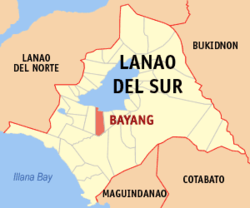Bayang: Difference between revisions
m cleanup (wikitables, html markup, layout, etc.) |
→Education: just to make short list |
||
| Line 140: | Line 140: | ||
* Upper Bayang National High School,Raya Bubong, Bayang, Lanao del Sur |
* Upper Bayang National High School,Raya Bubong, Bayang, Lanao del Sur |
||
Elementary Schools: |
Elementary Schools: |
||
{{columns-list|3| |
|||
* Dandamun Central Pilot School,Lower Bayang District |
* Dandamun Central Pilot School,Lower Bayang District |
||
* Rantian Elementary School |
* Rantian Elementary School |
||
| Line 178: | Line 179: | ||
* Malaa Alad |
* Malaa Alad |
||
* Dandamun Mosque |
* Dandamun Mosque |
||
}} |
|||
==References== |
==References== |
||
Revision as of 04:47, 8 March 2017
Bayang | |
|---|---|
 Map of Lanao del Sur with Bayang highlighted | |
| Coordinates: 07°47′35″N 124°11′31″E / 7.79306°N 124.19194°E | |
| Country | Philippines |
| Region | Bangsamoro Autonomous Region in Muslim Mindanao |
| Province | Lanao del Sur |
| Barangays | 49 |
| Government | |
| • Mayor | Aslanie Balt |
| • Vice Mayor | Johanisa Datudacula-Radiamoda |
| Area | |
| • Total | 230.00 km2 (88.80 sq mi) |
| Population (2020 census)[2] | |
| • Total | 28,023 |
| • Density | 120/km2 (320/sq mi) |
| Time zone | UTC+8 (PST) |
| ZIP code | 9309 |
| Dialing code | +63 (0)63 |
| Income class | 5th municipal income class |
| PSGC | 153604000 |
| Electorate | 17,574 voters as of 2022 |
| Website | www |
Bayang is a fifth class municipality in the province of Lanao del Sur, Philippines. According to the 2020 census, it has a population of 28,023 people.[2]
Battle of Bayang
In May 1902, during the Moro Rebellion (also known as the Moro–American War[3]), Bayang was the site of a clash between Moro rebels and American troops that became known as the Battle of Bayang. The American troops, three infantry battalions and a battery of artillery totaling some 1200 men, were led to Bayang by colonel Frank Baldwin to demand the extradition of the Moros responsible for the ambushing and killing of two American soldiers at the construction of a road from Iligan to Lake Lanao, two months earlier.[4]
When the sultan of Bayang refused, Baldwin's troops attacked and captured the nearby cotta (fortress; "small, castle-like structures with thick, high walls"[5]) of Binidayan on 2 May. They subsequently attempted to capture the cotta of Pandapatan, which resisted the artillery fire and was only subdued the next day after hand-to-hand combat between Moros and Americans. The number of Moro casualties is estimated at 300 to 400, including the sultan of Bayang and his brother. On the American side, ten soldiers were killed and some forty wounded.[4][5]
The cotta of Pandapatan has been preserved as a historical monument; the fallen of the Battle of Bayang are considered martyrs by Filipino Muslims.[3]
Barangays
Bayang is politically subdivided into 49 barangays.
Demographics
| Year | Pop. | ±% p.a. |
|---|---|---|
| 1990 | 18,928 | — |
| 1995 | 20,060 | +1.09% |
| 2000 | 21,020 | +1.01% |
| 2007 | 24,185 | +1.95% |
| 2010 | 21,472 | −4.24% |
| 2015 | 23,965 | +2.11% |
| Source: Philippine Statistics Authority[6][7][8] | ||
Education
Secondary Schools:
- Mauyag C. Papandayan National High School, Rinabor, Bayang, Lanao del Sur
- Bayang National High School, Biabi, Bayang, Lanao del Sur
- Upper Bayang National High School,Raya Bubong, Bayang, Lanao del Sur
Elementary Schools:
References
- ^ "Official City/Municipal 2013 Election Results". Intramuros, Manila, Philippines: Commission on Elections (COMELEC). 1 July 2013. Retrieved 5 September 2013.
- ^ a b Census of Population (2020). "Bangsamoro (BARMM)". Total Population by Province, City, Municipality and Barangay. Philippine Statistics Authority. Retrieved 8 July 2021.
- ^ a b Antonio J. Montalvan II (13 May 2002). "The war that no one remembers". Philippine Daily Enquirer.
- ^ a b Paul J. Springer (2009). "Bayang, Battle of". In Spencer Tucker (ed.). The Encyclopedia of the Spanish-American and Philippine-American Wars. Vol. 1. ABC-CLIO. pp. 49–50.
- ^ a b Alexander M. Bielakowski, ed. (2013). Ethnic and Racial Minorities in the U.S. Military. ABC-CLIO. p. 444.
{{cite encyclopedia}}: Missing or empty|title=(help) - ^ Census of Population (2015). "ARMM – Autonomous Region in Muslim Mindanao". Total Population by Province, City, Municipality and Barangay. Philippine Statistics Authority. Retrieved 20 June 2016.
- ^ Census of Population and Housing (2010). "ARMM – Autonomous Region in Muslim Mindanao" (PDF). Total Population by Province, City, Municipality and Barangay. National Statistics Office. Retrieved 29 June 2016.
- ^ Censuses of Population (1903–2007). "ARMM – Autonomous Region in Muslim Mindanao". Table 1. Population Enumerated in Various Censuses by Province/Highly Urbanized City: 1903 to 2007. National Statistics Office.
{{cite encyclopedia}}: CS1 maint: numeric names: authors list (link)

